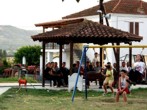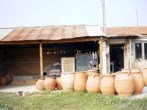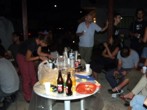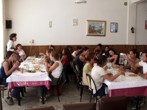|
|
| Inhabitants |
 The archaeological investigation at Paliambela gave the research team the opportunity to live with the local community. This contact with many aspects of the daily lives, history and character of the inhabitants revealed jovial and hospitable people accustomed to the difficulties and joys of farming life. The archaeological investigation at Paliambela gave the research team the opportunity to live with the local community. This contact with many aspects of the daily lives, history and character of the inhabitants revealed jovial and hospitable people accustomed to the difficulties and joys of farming life. |
| |
| Population history |
As occurred in many areas of Pieria after the exchange of populations in 1923, the population make-up of Paliambela changed with the settlement of refugees from Eastern Thrace. According to the population census of 1920, the small village population of 106 increased to 376. After the Second World War population levels stayed stable (266 inhabitants in 2001).  Today the village has descendents both of the indigenous inhabitants and of the refugees. Over the last few years the population has increased over the summers, since a significant number of economic immigrants (mainly from Albania) are employed in farming work in the area. Today the village has descendents both of the indigenous inhabitants and of the refugees. Over the last few years the population has increased over the summers, since a significant number of economic immigrants (mainly from Albania) are employed in farming work in the area. |
| |
| Occupations |
 The main occupation of the inhabitants is farming. The majority of the cultivated fields are taken up by the growing of cereals and tobacco. However, there are also vineyards used for the yearly homemade production of wine and raki. A number of inhabitants are also involved in livestock farming, with an emphasis on goats and sheep. Many inhabitants also work in Thessaloniki and other neighbouring towns, while each summer tourism jobs constitute another source of income. It is worth noting that Paliambela also houses the pottery workshop of Yiannis Stagides, who has been creating pottery using traditional techniques for many years. The main occupation of the inhabitants is farming. The majority of the cultivated fields are taken up by the growing of cereals and tobacco. However, there are also vineyards used for the yearly homemade production of wine and raki. A number of inhabitants are also involved in livestock farming, with an emphasis on goats and sheep. Many inhabitants also work in Thessaloniki and other neighbouring towns, while each summer tourism jobs constitute another source of income. It is worth noting that Paliambela also houses the pottery workshop of Yiannis Stagides, who has been creating pottery using traditional techniques for many years. |
| |
| Excavation activities |
The excavation is an important event for the village since each year the village fills with people and comes to life thanks to the significant number of researchers and students who stay there. A number of the inhabitants work for the excavation, helping the archaeological work, while everyday the excavation participants seek relaxing moments in the village cafes. Summer life in the village seems to revolve around archaeology and agricultural work, allowing for connections to be made between those who work under the hot sun. Common get-togethers are organised regularly (and usually spontaneously!), strengthening ties with the inhabitants. The archaeological project now undoubtedly forms part of the daily life of the village, and not just during the excavation seasons.
 
|
|
|





